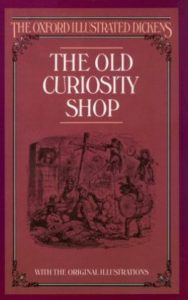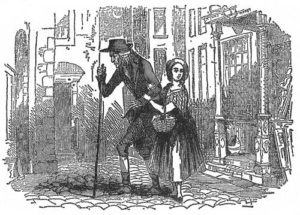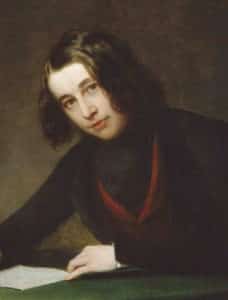Perhaps the first thing you notice when you read The Old Curiosity Shop by Charles Dickens is how little of it has to do with an old curiosity shop. The opening scenes are set in the shop, a place full of old antiques, curiosities, and junk, or “junque.” References will appear later in the sprawling tale, but they are fleeting.
Slowly you begin to understand that what Dickens wrote here was a road trip.
The Old Curiosity Shop was Dickens’ fourth work of fiction. He began to be known by his stories published in newspapers and periodicals, later collected as Sketches by Boz. Almost all of his fictional works were first serialized before being published as books. The Posthumous Papers of the Pickwick Club, or simply The Pickwick Papers, were published over 18 months from 1836 to 1837, and the work catapulted the author to national fame.

Then came The Old Curiosity Shop, published from April 1840 to November 1841. If interest in his work had been a wave, this book was more like a tsunami. The story has been told many times of how crowds of people in Boston and New York would await the docking of passenger ships from Britain, crying out for news of “Little Nell.” Not long after the final installment was published, Dickens and his wife Catherine toured the United States, where his reading public lionized him, and the press were offended by him (he kept talking about slavery, copyright, and other issues).
The central characters of the book are 14-year-old Nell Trent and her grandfather. We never learn the grandfather’s name; his last name couldn’t be surmised, either, since he was the father of Nell’s mother. We also never learn the name of “the single gentleman,” another key character who is the grandfather’s brother. Without names, they become types of good, loving characters.
Nell’s grandfather owns the curiosity shop. But he has a flaw that becomes the linchpin for what happens in the story. He is a gambling addict—when he senses a card game, he becomes a kind of Mr. Hyde to his usual Dr. Jekyll personality. Nell will even catch him stealing from her little purse, looking for money to continue playing cards.

Nell and her grandfather begin their “road trip” in a scene from the original publication
His gambling habit has led him to borrow money from Daniel Quilp, one of the most vivid evil characters ever created by Dickens (and he created a lot of them). Quilp torments his wife, his mother-in-law, his lawyer, the Grandfather, and anyone else who happens to cross his path—and he thoroughly enjoys inflicting torment. He takes possession of the shop, and he intends to take possession of Nell and her grandfather, too. So in the dark of night, they flee, and begin a road trip across southern England.
Dickens uses the road trip (as he did in The Pickwick Papers) to illustrate life in the villages and countryside. Nell, her grandfather, and the reader meet puppeteers who put on Punch and Judy shows. We are introduced to a kindly schoolmaster, mourning the decline and impending death of his best student. Like Nell, we join Mrs. Jarley’s traveling waxworks and sleep in her caravan wagon. We see the grandfather get taken by card sharps at a village pub, and we’re horrified when he agrees to help the card players rob Mrs. Jarley. We take a ride on a canal boat, landing in a city transformed by the Industrial Revolution. We walk a scarred, ugly landscape of human misery. And we end our journey at a village with an ancient church, somewhere near the Welsh border.

Charles Dickens in 1842
We feel the menace of Quilp, but we also experience the goodness of Kit Nubbles, who works at the shop and eventually rouses the ire of Quilp; the desperate search by the grandfather’s brother; and the transformation of Dick Swiveller from shallow, rather broke, and opportunistic to almost heroic in his efforts to save Kit. And we meet Quilp’s attorney, Sampson Brass, and his sister Sally, who treat their “small servant” more like a house slave. Dick Swiveller will name this servant “The Marchioness,” and she will aid in his rehabilitation and heroics.
The Old Curiosity Shop is a long story and a moving story, with scenes that caused me to laugh out loud and scenes that brought tears. Its narrative form is episodic, reflecting its serialization. But it remains an entertaining work, a reflection of the keen eye of Charles Dickens on the people and the times he lived in.
Related:
Rediscovering “Great Expectations” by Charles Dickens
The Strangeness of “A Tale of Two Cities” by Charles Dickens
The Surprise of “Oliver Twist” by Charles Dickens
“David Copperfield”: Why Charles Dickens Has Endured
Browse more book reviews
Photo by Greg Westfall, Creative Commons, via Flickr. Post by Glynn Young, author of the novels Dancing Priest, A Light Shining, and the newly published Dancing King, and Poetry at Work.
__________________________

“I require all our incoming poetry students—in the MFA I direct—to buy and read this book.”
—Jeanetta Calhoun Mish
- Poets and Poems: Michelle Ortega and “When You Ask Me, Why Paris?” - April 10, 2025
- Robert Waldron Imagines the Creation of “The Hound of Heaven” - April 8, 2025
- Poets and Poems: Luci Shaw and “An Incremental Life” - April 3, 2025

L.L. Barkat says
I love this grand summary of the story (and the notes about Dickens’ career—I’d never heard about him doing public readings in the U.S. and the response!). Also, that’s just so fun that people would wait for news of little Nell. Good storytellers do keep us wanting more. 🙂
Sandra Heska King says
Confession: I don’t think I’ve read anything by Dickens except a Christmas Carol. If I have, I don’t remember. I do remember Pickwick Papers in connection with the Little Women. I hope I live to be 200 years old. I’ve got a lot of reading to do.
Glynn says
I’ve learned that reading Dickens is a not insignificant investment of time, but it pays back much more.
Megan Willome says
Glynn, you had me at “road trip.”
Glynn says
The road trip surprised me. I had an image of the book in my head that it was all about an old antique shop. I was wrong.
Michele Morin says
Fascinating that Dickens was such a celebrity here in the States.
I love his voice, and this sounds like such a good story. There’s nothing like a great villain!
Margy says
I haven’t read a classic book in years. Maybe I should give one a try in between my more modern titles. – Margy
Glynn says
I love reading the classics. Dickens is a favorite, and starting last year I committed to read four of his books a year. I’ve started looking at George Eliot and Thomas Hardy, too. On the American side, there’s Nathaniel Hawthorne, Washington Irving, James Fenimore Cooper. Although I can’t say I’m ready to tackle Melville’s Moby Dick.